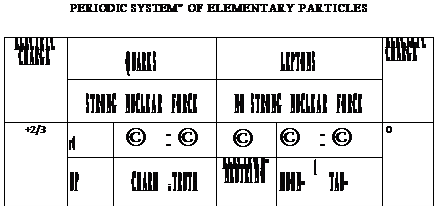4. What makes scientists believe in quark existence?
CLASSWORK
READING (19B)
• Skim the passage rapidly and answer the question given in the title.
ARE THERE FINAL INDIVISIBLE CONSTITUENTS OF MATTER?
Our present-day knowledge of the constituents of matter is summarized in the scheme given below. This scheme in away replaces the periodic table ofthe elements ofthe chemists of the last century. Certainly, it seems to be simpler.
ЛИ the particles shown are fermions, i.e. they have spin 1/2. The implication is that for particles of each kind a conservation law exists, meaning that they cannot be produced as single particles but only in particle-antiparticle pairs. There are two classes of particles: the leptons, which do not feel the nuclear force, and the quarks, which do. *Anothcr major difference is that quarks have 1/3 charge, whereas leptons have integer electrical charges. The particles in the first line of the scheme differ from those in the second line by one unit in electric charge. The two particles in each column form a family as regards weak interactions in the sense that they can be transformed into each other. Thus, in weak processes a "u" quark can be transformed into a "d" quark and vice versa, or an electron into an electron neutrino, etc. The mass ofthe particles increases from left to right. Thus, besides the electron, a heavy electron which is usually called a muon is known, and a couple of years ago a super-heavy electron, the "t" particle, was detected. Each of these electron-like particles has its own neutrino. *Although experimental upper limits on the masses of the neutrinos are known, one ofthe most interesting problems is whether the masses of these neutrinos are exactly zero or not.

Originally, three quarks (u, d and s) were known, but in the seventies the charm quark and the beauty quark were discovered. *Because ofthe supposed symmetry between leptons and quarks most physicists are convinced that a sixth quark, the top quark, must exist. So far we do not understand the rules governing the masses of these particles; hence it is not possible to predict the mass of a top quark. *Fora certain time it was hoped that it could be produced with a powerful accelerator but it seems to be heavier than the available energy would permit us to detect. It could be found with the pp collider. Several theorists have speculated that quarks and leptons might not be the ultimate constituents, but that there might be a deeper layer of matter. They introduced even smaller particles (sometimes called rishons orhaplons) out of which both quarks and leptons can be composed.
The "periodic system" of elementary particles showing the two families, the quarks and the leptons, which are thought to be the fundamental constituents of matter. They are all fermions (spin equal to 1 /2) and their masses increase from left to right in the diagram. The "t" (top or truth) quark has not yet been found.
• Choose the proper word from the list below.








